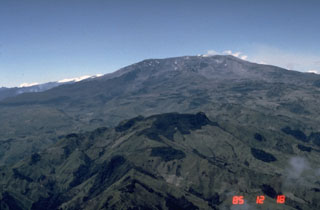Report on Nevado del Ruiz (Colombia) — 14 May-20 May 2025
Smithsonian Institution / US Geological Survey
Weekly Volcanic Activity Report, 14 May-20 May 2025
Managing Editor: Sally Sennert.
Please cite this report as:
Global Volcanism Program, 2025. Report on Nevado del Ruiz (Colombia) (Sennert, S, ed.). Weekly Volcanic Activity Report, 14 May-20 May 2025. Smithsonian Institution and US Geological Survey.
Nevado del Ruiz
Colombia
4.892°N, 75.324°W; summit elev. 5279 m
All times are local (unless otherwise noted)
The Servicio Geológico Colombiano’s (SGC) Observatorio Vulcanológico y Sismológico de Manizales reported that eruptive activity at Nevado del Ruiz continued during 13-19 May. Seismic data indicated that events associated with fluid movement decreased in both number and intensity compared to the previous week. Seismicity associated with rock fracturing increased in both number and intensity compared to the previous week. The earthquakes were mainly located below Arenas Crater and the NE and SW flanks within 12 km at depths of 1-7 km. Seismicity indicating growth of the lava dome remained at low levels. Low-energy thermal anomalies on the crater floor were identified in satellite data, though weather clouds often obscured views. Significant sulfur dioxide emissions continued to be detected in satellite data. Gas-and-steam plumes rose as high as 500 m above the summit and drifted NW, WNW, and W. The only confirmed gas-and-ash plume during the week rose 700 m above the summit at 0837 on 17 May. The Alert Level remained at Yellow (the second level on a four-level scale).
Geological Summary. Nevado del Ruiz is a broad, glacier-covered volcano in central Colombia that covers more than 200 km2. Three major edifices, composed of andesitic and dacitic lavas and andesitic pyroclastics, have been constructed since the beginning of the Pleistocene. The modern cone consists of a broad cluster of lava domes built within the caldera of an older edifice. The 1-km-wide, 240-m-deep Arenas crater occupies the summit. The prominent La Olleta pyroclastic cone located on the SW flank may also have been active in historical time. Steep headwalls of massive landslides cut the flanks. Melting of its summit icecap during historical eruptions, which date back to the 16th century, has resulted in devastating lahars, including one in 1985 that was South America's deadliest eruption.

